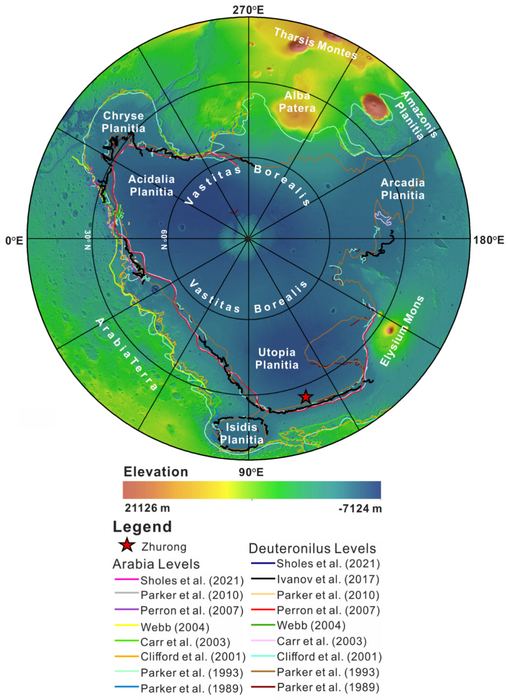In a recent study published in National Science Review, a team of researchers led by the China University of Geosciences discuss direct evidence of an ancient ocean and its shoreline that existed in the northern hemisphere of Mars during the Hesperian Period, or more than 3 billion years ago. This finding is based on data collected by the China National Space Agency’s (CNSA) Zhurong rover in the Vastitas Borealis Formation (VBF), which lies within southern Utopia Planitia on Mars. The Zhurong rover landed in Utopia Planitia on May 15, 2021, after being ferried across the void from Earth to Mars by the Tianwen-1 orbiter, which is still active around the Red Planet.
Zhurong was initially designed for a mission duration of 90 sols (93 Earth days) and has far exceeded that timeline. However, Zhurong entered hibernation mode in May 2022 (Sol 347) to protect itself during the harsh Martian winter. While it was scheduled to resume communications with the CNSA in December 2022, it did not, and the CNSA recently admitted it might be gone for good.
During its mission, Zhurong has traversed 1,921 meters (6,302 feet), or just under 2 kilometers (1. 24 miles) and its elevation has decreased by approximately 5 meters (16. 4 feet).
Throughout this trek, the researchers used Zhurong’s multispectral camera (MSCam) to conduct in situ analyses of 23 rocks from 106 pairs of panoramic images, and the observations Zhurong made were striking. a) Base map of a is HiRIC (HX1_GRAS_HIRIC_DIM_0. 7_0004_251515N1095850E_A) (Figure 1 of the study); b) HiRISE DEM (DTEEC_069665_2055_069731_2055) overlain on the HiRIC.
The red star denotes Zhurong’s landing site, with the rover traveling just under 2 kilometers (1. 24 miles) between its landing site and Zhurong’s last known location (Sol_344), with an elevation decrease of approximately 5 meters (16. 4 feet).
(Credit: ©Science China Press) “When we examined the photos sent back by those cameras, we found that these exposed rocks exhibited distinct layering structures, which were significantly different from the common volcanic rocks found on the Martian surface or the layering structures formed by wind-blown sand deposits,” said Dr. Xiao Long, who is a professor in the School of Earth Sciences at the China University of Geosciences, and lead author of the study. “These layering structures indicate the characteristics of bidirectional water flow, consistent with the low-energy tidal currents observed in terrestrial coastal environments on Earth.
” Essentially, the study discovered evidence of an ancient shoreline that exhibited tides on Mars based on the rover’s images, which re-examines a multitude of past studies that attempted to draw ancient Martian shorelines using orbiter data, whereas this mission was the first to conduct a direct in situ analysis on the topic. Elevation map of the northern hemisphere of Mars with the red star denoting the landing site of the Zhurong rover, which is ~282 kilometers (~175 miles) north of a previously proposed shoreline of the ancient Deuteronilus ocean. The different colored lines represent proposed shorelines from past studies.
(Credit: ©Science China Press) On Earth, tides both advance and retreat from the shoreline from the gravitational tug with our Moon. The researchers hypothesize that since Mars has two moons, these tides could still exist in ancient ocean, although at smaller scales. The sedimentary structures observed in the images support the hypothesis that these structures were laid down from water flow, as opposed to wind deposits.
The researchers also deduce that these sedimentary structures could have been laid down during a large retreat of an ancient ocean during the Hesperian Period, as well. Like Earth, the geologic history of Mars is split into various Epochs, also known as periods: Noachian, Hesperian, and Amazonian. The Noachian Period is estimated to have occurred between 4.
1 and 3. 7 billion years ago, the Hesperian Period between 3. 7 and 2.
9 billion years ago, and the Amazonian Period began 2. 9 billion years ago and continues to the present day. While a Pre-Noachian period has been identified and discussed within the scientific community to have occurred between 4.
5 and 4. 1 billion years ago, no direct evidence of its existence has been found. Artist depiction of an ancient northern ocean on Mars billions of years ago.
(Credit: NASA/Goddard Space Flight Center) With these incredible findings by the Zhurong rover, scientists gain new insights into the history of Mars and how much different it might have looked billions of years ago compared to the cold and dry planet it is today. “Future exploration and sample return missions to this region will further deepen our understanding of Mars’ habitability and the preservation of traces of life,” said Dr. Long.
Numerous plans are in the works for a sample return mission from Mars by both NASA and China, as the former is collaborating with the European Space Agency (ESA) to bring Mars samples back to Earth by 2033, and China has announced a timeline that would bring samples back in 2031, beating the NASA/ESA effort by two years. The NASA Perseverance rover recently started collecting samples and dropping sample tubes filled with Martian regolith and pebbles to be later collected by a sample return mission, which is currently one step ahead of China. What new discoveries will scientists make about ancient Mars and its ancient shorelines in the coming years and decades? Only time will tell, and this is why we science! As always, keep doing science & keep looking up! The post China’s Rover Found Evidence of an Ancient Ocean on Mars appeared first on Universe Today.
.
From: universetoday
URL: https://www.universetoday.com/161601/chinas-rover-found-evidence-of-an-ancient-ocean-on-mars/



